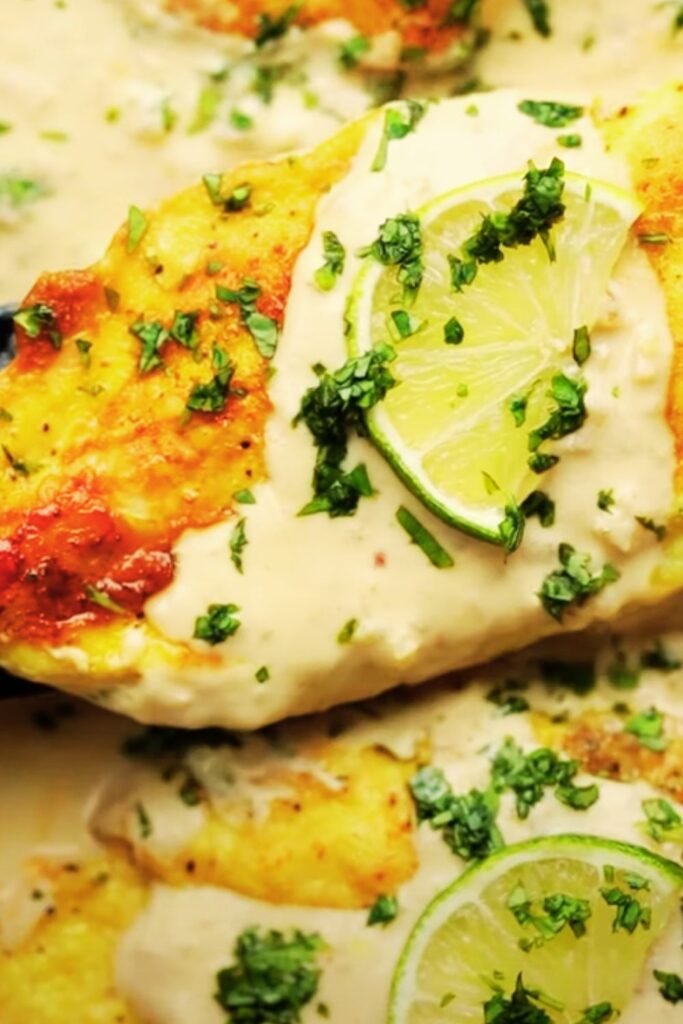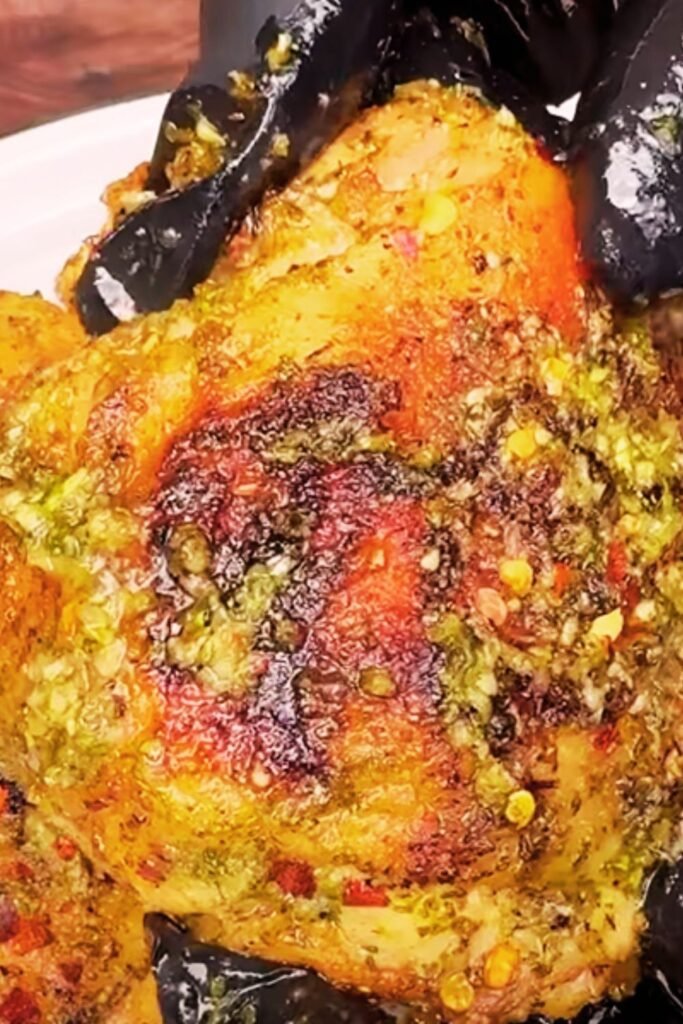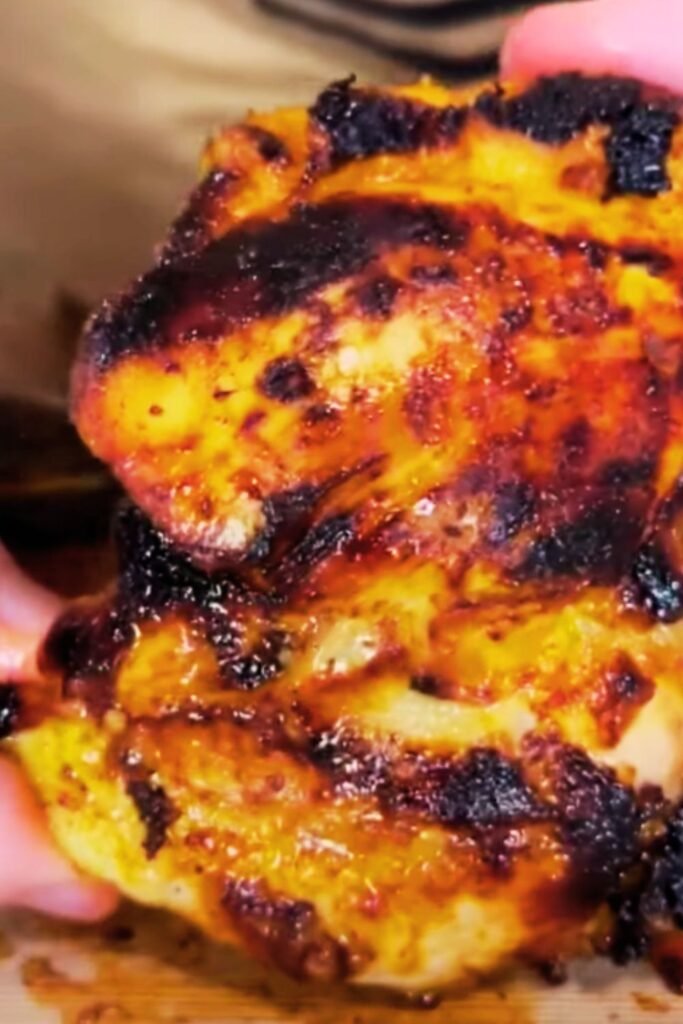I stumbled upon this incredible Sweet Chili Coconut-Lime Grilled Chicken recipe during a particularly humid summer evening when I was desperately trying to create something that would awaken my family’s tired taste buds. After countless experiments in my backyard kitchen laboratory, I finally struck gold with this harmonious blend of tropical flavors that transforms ordinary chicken into something extraordinary.
The magic happens when sweet chili sauce meets creamy coconut milk, creating a marinade that’s both exotic and familiar. What sets this recipe apart isn’t just the flavor profile—it’s how these ingredients work together to create tender, juicy chicken with a gorgeous caramelized exterior that makes your mouth water just thinking about it.
I’ve served this dish to skeptical teenagers, picky in-laws, and even my neighbor who claims to hate “fancy food.” Every single person has asked for the recipe, and I’ve watched grown adults literally lick their plates clean. That’s when I knew I had something special on my hands.
The beauty of this recipe lies in its deceptive simplicity. While the flavor profile tastes complex and restaurant-worthy, the actual preparation is straightforward enough for a weeknight dinner. The marinade does most of the heavy lifting, infusing the chicken with layers of sweet, spicy, and citrusy goodness that penetrate deep into the meat.
Understanding the Essential Components
Sweet Chili Sauce: This glossy, amber-colored condiment originates from Thai cuisine and combines red chilies, sugar, garlic, and rice vinegar to create a perfect balance of heat and sweetness with a slightly sticky consistency.
Coconut Milk: The rich, creamy liquid extracted from grated coconut meat contains natural enzymes that help tenderize proteins while adding tropical richness and subtle sweetness.
Fresh Lime Juice: The acidic component that not only brightens the entire flavor profile but also acts as a natural meat tenderizer by breaking down tough protein fibers.
Fish Sauce: A fermented anchovy-based condiment that provides umami depth and saltiness without overwhelming the other flavors—think of it as the secret weapon that makes everything taste more itself.
Fresh Ginger: The aromatic root that adds warmth, slight heat, and a clean, bright flavor that complements both the coconut and lime perfectly.
Complete Ingredient Breakdown
| Primary Ingredients | Quantity | Role in Recipe | Best Substitutes |
|---|---|---|---|
| Chicken (thighs or breasts) | 2.5 lbs | Main protein base | Turkey cutlets, pork chops |
| Sweet chili sauce | 3/4 cup | Flavor foundation | Sriracha + honey (2:1 ratio) |
| Full-fat coconut milk | 1/2 cup | Richness & tenderizing | Heavy cream + coconut extract |
| Fresh lime juice | 1/3 cup | Acidity & brightness | Fresh lemon juice |
| Fish sauce | 3 tablespoons | Umami depth | Low-sodium soy sauce |
| Fresh ginger, grated | 2 tablespoons | Aromatic warmth | Ground ginger (1 teaspoon) |
| Garlic cloves, minced | 5 cloves | Savory base | Granulated garlic (1 teaspoon) |
| Light brown sugar | 3 tablespoons | Enhanced sweetness | Coconut sugar, honey |
| Sesame oil | 1 tablespoon | Nutty richness | Vegetable oil |
| Kosher salt | 1 teaspoon | Flavor enhancement | Sea salt |
| Freshly ground black pepper | 3/4 teaspoon | Warm spice | White pepper |
| Red pepper flakes | 1/2 teaspoon | Heat level control | Cayenne pepper |
Essential Preparation Steps
Creating the Perfect Marinade
I start by whisking the coconut milk in a large mixing bowl until it’s completely smooth—sometimes the cream separates, so this step ensures everything combines properly. Then I add the sweet chili sauce gradually, whisking constantly to prevent any lumps from forming. The mixture should have a beautiful coral color and silky texture.
Next comes the fresh lime juice, which I add slowly while continuing to whisk. The acidity can sometimes cause the coconut milk to curdle if added too quickly, so patience is key here. I always use freshly squeezed lime juice because bottled versions lack the bright, clean flavor that makes this marinade sing.
The aromatics go in next—minced garlic and freshly grated ginger. I use a microplane grater for the ginger because it creates a fine paste that distributes evenly throughout the marinade. The fish sauce follows, and I whisk everything together until the mixture is completely homogeneous.
Preparing the Chicken
Whether I’m using thighs or breasts, I always start by patting the chicken completely dry with paper towels. Excess moisture prevents the marinade from adhering properly and can lead to steaming instead of proper grilling. I trim any visible fat and remove the skin if I want a leaner result, though I often leave it on for extra flavor and moisture.
For chicken breasts, I pound them to an even thickness of about 3/4 inch using a meat mallet. This ensures uniform cooking and prevents the dreaded scenario where the outside is overcooked while the inside remains raw. I place the chicken in a gallon-sized zip-top bag and pour the marinade over it, making sure every piece is thoroughly coated.
The marinating process requires patience. While the chicken can be grilled after just one hour, I prefer to let it marinate for at least four hours, or ideally overnight. The longer marinating time allows the flavors to penetrate deeper into the meat and the natural enzymes in the coconut milk to work their tenderizing magic.

Grilling Technique and Temperature Control
I preheat my grill to medium-high heat, aiming for around 425°F to 450°F. This temperature is hot enough to create beautiful sear marks and caramelize the sugars in the marinade without burning them. I always clean the grates thoroughly with a wire brush and oil them well to prevent sticking.
Before placing the chicken on the grill, I remove it from the marinade and let the excess drip off. I reserve about half a cup of the marinade for basting, but I always bring it to a rolling boil for at least two minutes to eliminate any bacteria from the raw chicken contact.
The initial sear is crucial for developing those gorgeous grill marks and locking in the juices. I place the chicken on the hottest part of the grill and resist the urge to move it around. The chicken will naturally release from the grates when it’s ready to flip—usually after about 4-5 minutes for boneless pieces.
Precise Cooking Guidelines
| Chicken Cut | Initial Sear Time | Total Cooking Time | Internal Temperature |
|---|---|---|---|
| Boneless thighs | 4-5 minutes per side | 14-18 minutes | 165°F (74°C) |
| Bone-in thighs | 5-6 minutes per side | 22-28 minutes | 165°F (74°C) |
| Boneless breasts | 4-5 minutes per side | 10-14 minutes | 165°F (74°C) |
| Bone-in breasts | 5-6 minutes per side | 18-22 minutes | 165°F (74°C) |
I always use an instant-read thermometer to check doneness because visual cues can be deceiving, especially with a darkly colored marinade. The thermometer should be inserted into the thickest part of the meat, avoiding any bones which can give false readings.
During the last few minutes of cooking, I brush the chicken with the reserved marinade. This creates a beautiful glaze and adds an extra layer of flavor while helping to achieve that gorgeous caramelized exterior that makes this dish so visually appealing.
Flavor Customization Options
Adjusting Heat Levels
For families with varying spice tolerances, I’ve developed several modifications. To reduce heat, I substitute half the sweet chili sauce with apricot preserves and omit the red pepper flakes entirely. For those who crave more fire, I add fresh Thai chilies or a tablespoon of sambal oelek to the marinade.
I’ve also experimented with different types of chilies. Jalapeños provide a fresh, green heat that’s quite different from the sweet chili sauce, while chipotle peppers add a smoky dimension that pairs beautifully with the grilled flavor.
Citrus Variations
While lime is traditional and my preferred choice, I’ve successfully used other citrus fruits. Orange juice creates a sweeter, more mellow profile that’s perfect for kids, while grapefruit juice adds a slightly bitter edge that sophisticated palates appreciate. I’ve even combined lime and lemon juice for a more complex citrus profile.
Herb and Aromatics Enhancement
Fresh lemongrass, when I can find it, adds an incredible aromatic quality to the marinade. I bruise a couple of stalks and add them to the marinade, removing them before grilling. Thai basil leaves can be torn and mixed into the marinade for an additional layer of complexity.

Serving Suggestions and Pairings
This grilled chicken pairs beautifully with jasmine rice, which I cook in coconut milk instead of water for extra richness. The rice absorbs the flavorful juices that drip from the chicken, creating a cohesive meal where every component enhances the others.
I often prepare a simple Asian-style cucumber salad with rice vinegar, sesame oil, and a touch of sugar. The cool, crisp texture provides a refreshing contrast to the rich, warm chicken. Grilled vegetables like bell peppers, zucchini, and red onions also complement the flavors perfectly.
For a more substantial meal, I serve it with coconut rice and a mango salsa made with diced mango, red onion, jalapeño, and lime juice. The sweetness of the mango echoes the coconut-lime flavors in the chicken while adding fresh, tropical notes.
Storage and Meal Prep Strategies
This recipe is fantastic for meal prep because the flavors actually improve over time. I often grill extra chicken on Sunday and use it throughout the week in various applications. The leftover chicken keeps well in the refrigerator for up to five days when stored in an airtight container.
For reheating, I avoid the microwave which can make the chicken rubbery. Instead, I slice the cold chicken and quickly warm it in a skillet over medium heat, or reheat whole pieces in a 350°F oven for about 10 minutes until heated through.
The chicken also freezes beautifully for up to three months. I wrap individual portions in plastic wrap, then store them in freezer bags with the air removed. To use, I thaw them overnight in the refrigerator and reheat as described above.
Nutritional Benefits and Health Considerations
This recipe offers several nutritional advantages that make it a healthy choice for regular meal rotation. Chicken is an excellent source of lean protein, providing all essential amino acids necessary for muscle maintenance and repair. A single serving provides approximately 35-40 grams of high-quality protein.
The coconut milk contributes healthy fats, particularly medium-chain triglycerides (MCTs) which are metabolized differently than other fats and may provide sustained energy. The ginger and garlic provide anti-inflammatory compounds and antioxidants that support immune function.
By grilling rather than frying, we avoid excessive added fats while developing complex flavors through the Maillard reaction. The lime juice adds vitamin C and helps with iron absorption from the meat.
Troubleshooting Common Challenges
Preventing Marinade Burn
The sugars in sweet chili sauce can burn quickly if the heat is too high. If I notice the marinade darkening too rapidly, I immediately move the chicken to a cooler area of the grill and reduce the heat. Creating different temperature zones on the grill is essential for success with this recipe.
Achieving Even Cooking
Uneven cooking usually results from pieces of varying thickness. I always pound chicken breasts to uniform thickness and try to select thighs that are similar in size. If I’m cooking both thighs and breasts, I start the thighs first since they take longer to cook through.
Preventing Dry Chicken
Overcooking is the enemy of juicy chicken. I rely on my thermometer rather than timing alone and remove the chicken as soon as it reaches 165°F. The residual heat will bring it up another few degrees while resting, ensuring it’s fully cooked but not overdone.

Advanced Techniques for Perfect Results
After years of perfecting this recipe, I’ve discovered several techniques that elevate the final result. First, I always bring the chicken to room temperature before grilling. Cold chicken straight from the refrigerator cooks unevenly, with the outside becoming overcooked before the center reaches a safe temperature.
Second, I’ve learned to read the grill like a book. Different areas have different heat levels, and I use this to my advantage. I sear the chicken over the hottest area, then move it to medium heat to finish cooking. This prevents burning while ensuring proper doneness.
Third, I never press down on the chicken with a spatula. This common mistake squeezes out the flavorful juices that we’ve worked so hard to develop through marination. Instead, I let the chicken cook undisturbed, trusting the process.
Questions and Answers
Q: Can I use chicken drumsticks or wings with this marinade? Absolutely! Drumsticks and wings work wonderfully with this marinade. They’ll need longer cooking time—about 25-30 minutes for drumsticks and 20-25 minutes for wings. I recommend starting them over indirect heat to cook through, then moving to direct heat for the final caramelization.
Q: What if I don’t have a grill? Can I make this in the oven? Yes, you can absolutely make this in the oven! Preheat to 425°F and place the marinated chicken on a rimmed baking sheet lined with foil. Bake for 20-25 minutes for boneless pieces, or until the internal temperature reaches 165°F. For extra caramelization, broil for the last 2-3 minutes.
Q: How can I make this recipe dairy-free? Great news—this recipe is already dairy-free! Coconut milk is plant-based, and there are no dairy products in the marinade. Just double-check that your sweet chili sauce doesn’t contain any dairy ingredients, though most commercial brands are dairy-free.
Q: Can I marinate the chicken for longer than overnight? I don’t recommend marinating for more than 24 hours. The acid in the lime juice will start to break down the protein structure, resulting in a mushy texture. If you need to prep further ahead, you can mix the marinade and freeze it with the chicken, then thaw and grill when ready.
Q: What’s the best way to prevent the chicken from sticking to the grill? Clean, well-oiled grates are essential. I heat the grill, scrub the grates with a wire brush, then oil them with a paper towel dipped in vegetable oil. Also, don’t try to flip the chicken too early—it will release naturally when it’s ready.
Q: Can I use this marinade for other proteins? Definitely! This marinade works beautifully with pork tenderloin, salmon, shrimp, and even tofu. Adjust the cooking times accordingly—seafood cooks much faster than chicken, while pork might need a bit longer.
Q: How do I know when the chicken is properly caramelized? Look for a deep golden-brown color with slightly darker edges. The surface should appear glossy from the caramelized sugars. If it’s getting too dark but the chicken isn’t cooked through, move it to a cooler part of the grill to finish cooking.
Q: Can I make a bigger batch of marinade and store it? Yes, you can double or triple the marinade recipe and store unused portions in the refrigerator for up to one week, or freeze for up to three months. Just remember to bring it to a boil if it’s been in contact with raw chicken.
This Sweet Chili Coconut-Lime Grilled Chicken has earned its place as one of my most-requested recipes because it delivers complex, restaurant-quality flavors with straightforward home cooking techniques. The tropical flavor profile transports you to warmer places while being approachable enough for everyday cooking. Whether you’re hosting a backyard barbecue or looking for a special weeknight dinner, this recipe consistently delivers impressive results that will have everyone asking for seconds.